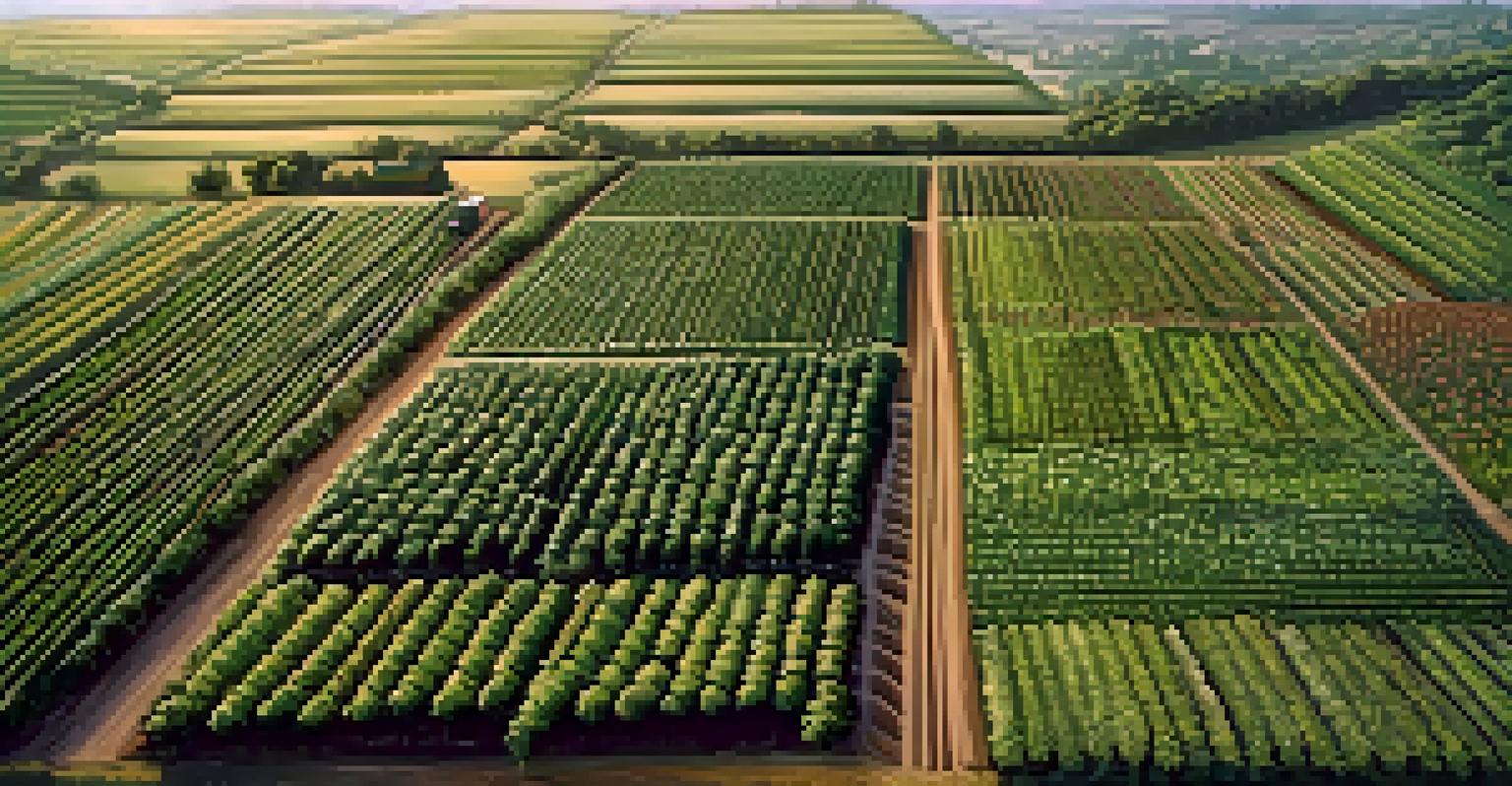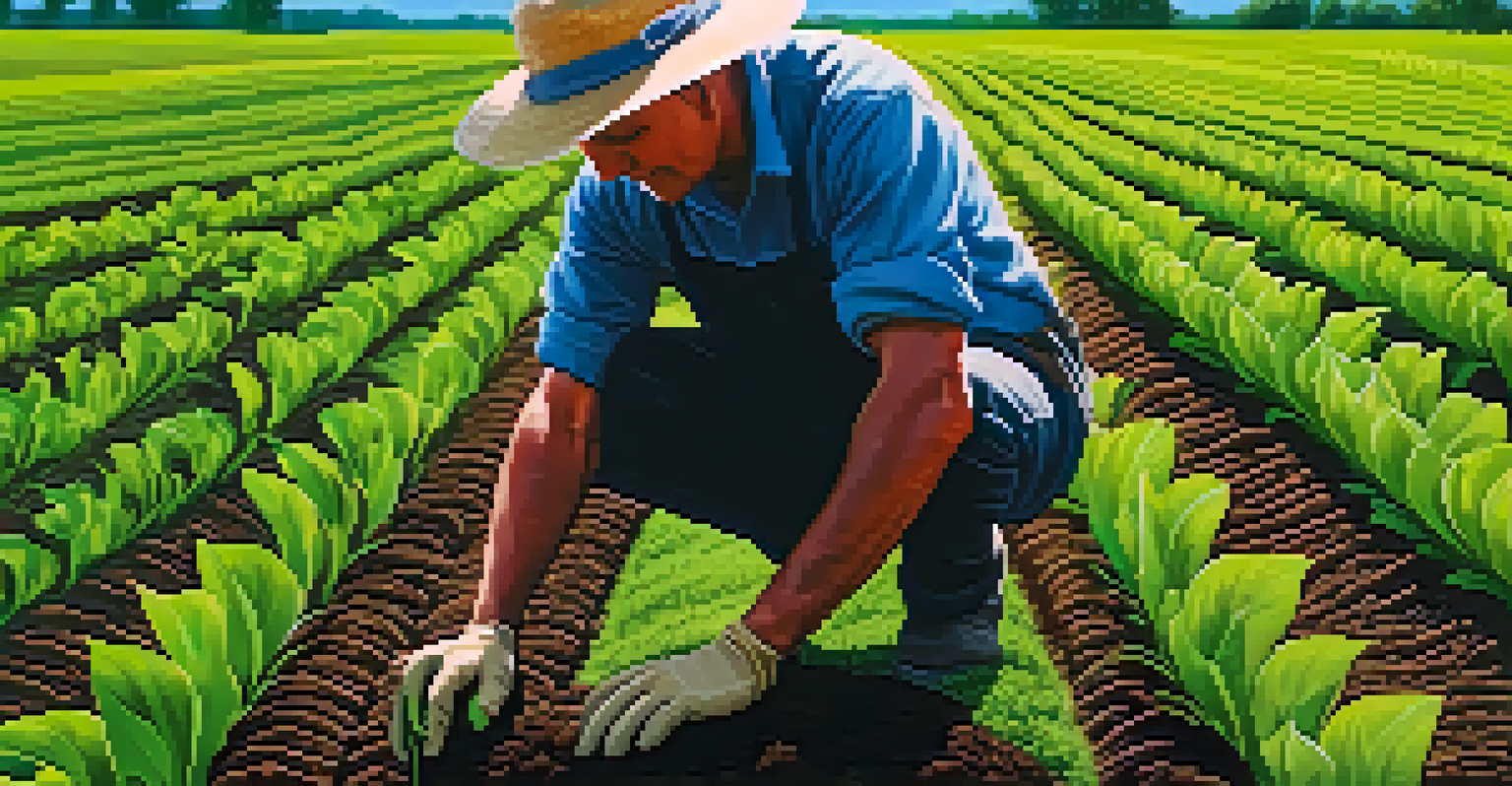Integrating Agroforestry into Climate Adaptation Plans

Understanding Agroforestry and Its Benefits
Agroforestry is a sustainable land-use system that combines trees, crops, and sometimes livestock in a single farming practice. This method not only enhances biodiversity but also improves soil health and increases agricultural productivity. By integrating trees into farming systems, farmers can benefit from better microclimates and reduced soil erosion. Ultimately, agroforestry creates a more resilient agricultural landscape.
Agroforestry is a powerful tool in the fight against climate change, providing both ecological and economic benefits.
One of the standout benefits of agroforestry is its ability to sequester carbon, helping mitigate climate change. Trees capture carbon dioxide from the atmosphere, storing it in their biomass and the soil. This dual benefit of enhancing farm yields while combating climate change is a win-win situation for farmers and the environment. As such, integrating agroforestry into climate adaptation plans is a smart and effective strategy.
Moreover, agroforestry provides diverse income sources for farmers. By cultivating multiple crops and incorporating trees, farmers can ensure food security and economic stability. This diversity acts as a safety net during adverse weather events, such as droughts or floods, making communities more resilient to climate impacts.
The Role of Agroforestry in Climate Adaptation Plans
Incorporating agroforestry into climate adaptation plans offers a holistic approach to resilience. These plans aim to prepare communities and ecosystems for the impacts of climate change, and agroforestry can play a vital role in that. For instance, integrating tree cover can significantly reduce the risk of soil degradation and increase water retention, which is crucial for maintaining crop yields in the face of changing weather patterns.

Additionally, agroforestry systems can help buffer communities against extreme weather events. The presence of trees can act as windbreaks, reducing the severity of storms and protecting crops and livestock. This protective layer not only safeguards agricultural assets but also enhances community safety and well-being.
Agroforestry Enhances Resilience
Integrating agroforestry into farming practices boosts biodiversity, improves soil health, and creates a more resilient agricultural landscape.
Furthermore, agroforestry promotes biodiversity, which is essential for healthy ecosystems. A diverse ecosystem can better withstand pests and diseases, reducing the need for chemical interventions. This aspect of agroforestry aligns perfectly with climate adaptation goals, fostering a more sustainable and resilient agricultural future.
Case Studies: Success Stories of Agroforestry
Many regions around the world have successfully integrated agroforestry into their climate adaptation strategies. For example, in East Africa, farmers have adopted agroforestry techniques to combat desertification and restore degraded lands. By planting trees alongside crops, they have improved soil fertility and increased their agricultural output, showcasing the power of agroforestry in enhancing resilience.
The integration of trees into agricultural systems is not just about improving productivity; it’s about creating a sustainable future for our planet.
In Brazil, agroforestry practices in the Amazon have been pivotal in balancing agricultural needs with environmental conservation. Farmers utilize mixed cropping systems that include native trees, which not only provide shade but also produce fruits and nuts for additional income. This approach has proven effective in mitigating deforestation while supporting local livelihoods.
These success stories illustrate that agroforestry is not just a theoretical concept but a practical solution that can be tailored to various regions and climates. By learning from these examples, other communities can adopt similar strategies to enhance their climate adaptation efforts.
Challenges in Implementing Agroforestry
Despite its numerous benefits, integrating agroforestry into climate adaptation plans comes with challenges. One significant hurdle is the need for knowledge and training among farmers. Many may lack the understanding of how to effectively implement agroforestry practices, leading to suboptimal results. Addressing this educational gap is crucial for successful integration.
Additionally, there may be resistance to changing traditional farming practices. Farmers often have established routines that may not include agroforestry, making it difficult to convince them to adopt new methods. Engaging communities through awareness campaigns and demonstration projects can help alleviate these concerns and encourage a shift towards agroforestry.
Supports Climate Adaptation
Agroforestry plays a vital role in climate adaptation plans by mitigating climate change effects and protecting communities from extreme weather events.
Lastly, securing funding and resources for agroforestry projects can be a challenge. While the benefits are clear, initial investments in trees and training can be perceived as a barrier. However, with the right support and commitment from governments and organizations, these challenges can be overcome, paving the way for successful agroforestry integration.
Policy Recommendations for Agroforestry Integration
To effectively incorporate agroforestry into climate adaptation plans, policymakers need to create supportive frameworks. This includes providing financial incentives for farmers who adopt agroforestry practices, such as grants or subsidies. Such incentives can ease the initial financial burden, encouraging more farmers to make the switch.
Additionally, policies should focus on education and training programs for farmers. By equipping them with the necessary skills and knowledge, they can better understand how to implement agroforestry systems effectively. Workshops, field days, and partnerships with local agricultural organizations can facilitate this learning process.
Lastly, collaboration among stakeholders is vital. Governments, NGOs, and agricultural experts should work together to develop comprehensive strategies that promote agroforestry. By fostering a collaborative environment, communities can share best practices and resources, enhancing the overall effectiveness of climate adaptation plans.
The Future of Agroforestry in Climate Adaptation
The future of agroforestry looks promising, especially as the impacts of climate change become increasingly apparent. As more communities recognize the benefits of integrating trees into their farming systems, we can expect to see a significant shift towards these sustainable practices. This transition not only has the potential to enhance agricultural productivity but also to safeguard the environment.
Moreover, advancements in technology and research will play a crucial role in the evolution of agroforestry. Innovative tools and techniques can help farmers optimize their agroforestry systems, making them more efficient and effective. This synergy between tradition and technology will pave the way for a new era of sustainable farming.
Challenges and Policy Needs
Successful agroforestry implementation requires addressing knowledge gaps, resistance to change, and securing financial support through effective policies.
Ultimately, as we face the challenges posed by climate change, agroforestry presents a viable solution that aligns with environmental preservation and food security. By embracing this approach, we can build a more resilient future for both communities and ecosystems, proving that sustainable practices are not just beneficial but essential.
Conclusion: Embracing Agroforestry for Resilience
In conclusion, integrating agroforestry into climate adaptation plans is not just a trend; it's a necessity for building resilience against climate change. This multifaceted approach offers a range of benefits, from increased biodiversity to improved soil health, making it an invaluable tool for farmers and communities alike. As we've seen through various case studies, agroforestry can effectively mitigate the impacts of climate change while enhancing agricultural productivity.
However, to realize its full potential, we must address the challenges associated with its implementation. By investing in education, policy support, and community engagement, we can break down barriers and promote the widespread adoption of agroforestry practices. The collaboration among stakeholders will be key to ensuring that these strategies are effective and sustainable.

Ultimately, the journey towards integrating agroforestry into climate adaptation plans is a shared responsibility. By working together, we can ensure a sustainable and resilient future for our agricultural systems, communities, and the planet as a whole.